Accepted Scientific Name: Mammillaria bombycina Quehl
Monatsschr. Kakteenk. 20: 149 (fig.). 1910
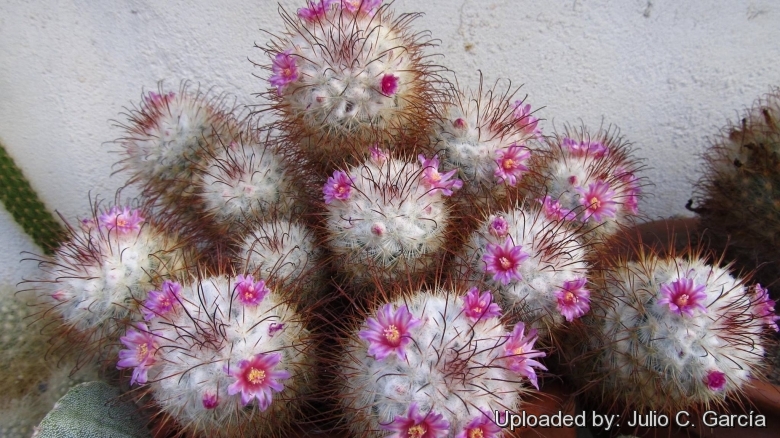
Escobariopsis bombycina (Mammillaria bombycina) Photo by: Julio C. García
is one of the most popular and beautiful species that will produce clumps, as a washing up bowl. It combines clean, glassy white radial spines with hooked reddish-brown centrals.
The spines are quite sticking. This plant will produce several complete circles of contrasting light carmine flowers every year.
Origin and Habitat: Originally described from eastern Jalisco, Mexico, additional populations have since been located in Aguascalientes just to the north. The area covers around 16 x 10 km. (extent of occurrence =160 km2, one location) .
Altitude: 2340 to 2600 metres above sea level.
Habitat and Ecology: It occurs in high mountains, in Quercus (oak) forests on steep slopes and grows in leaf-litter and sometimes on inaccesable cliffs together with Mammillaria fuscohamataSN|9237]]SN|9237]], Arctostaphylos pungens, Acacia farinosa, Agave filiferaSN|10450]]SN|10450]], and Opuntia jaliscana. In the past illegal collection was a major threat, however, today this species is widely available from propagation and the pressure in wild populations is minimum.
Synonyms:
See all synonyms of Mammillaria bombycina
Common Names include:
ENGLISH: Silken Pincushion
RUSSIAN (Русский): Маммиллярия атласная
UKRAINIAN (Українська): Мамілярія бомбіцина, Мамілярія шовкова
Description: Mammillaria bombycinaSN|9007]]SN|9007]] is a popular solitary or clustering species, some clones cluster aggressively and can form 50-90 cm wide, gorgeous mounds as they matures.
Stems: Depressed globose to club shaped, bright-green to grey-green, 7-14 cm high, 5-6 cm in diameter.
Tubercles: Conical to cylindrical, firm, latex in tubercules only occasionally. Axil: With dense wool and bristles.
Radial spine: 30-65, have a glassy appearance white, to yellowish white stiff, thin, needle-like, pectinately arranged, that almost conceal the epidermis to 8 mm long.
Central spine: 3-8 (usually 4), yellow with dark tips, or orange-reddish brown, lowermost one hooked downwards and to 20 mm long, others straight and to 11 mm long. hooked spines.
Radial spines: Many, 30-64, stiff, thin, needle-like, pectinated, glassy white to yellowish white, up to 8 mm.
Flower: Light carmine, pink or white, funnelform, to 15 mm long and in diameter in circles around the crown of the plant.
Blooming: Come only to mature plants in Spring
Fruits: Pale pinkish green.
Remarks: Mammillaria bombycinaSN|9007]]SN|9007]] ssp. perezdelarosae is often condidered a good species. Therefore in this assessment only Mammillaria bombycinaSN|9007]]SN|9007]] is considered.
Subspecies, varieties, forms and cultivars of plants belonging to the Mammillaria bombycina group
 Mammillaria bombycina Quehl: Solitary or clustering cactus, some clones cluster aggressively and can form 50-90 cm wide mounds. It combines clean, glassy white radial spines with hooked reddish-brown centrals.This plant will produce several complete circles of contrasting light carmine flowers.
Mammillaria bombycina Quehl: Solitary or clustering cactus, some clones cluster aggressively and can form 50-90 cm wide mounds. It combines clean, glassy white radial spines with hooked reddish-brown centrals.This plant will produce several complete circles of contrasting light carmine flowers.- Mammillaria bombycina f. albicentralis hort.: Has evenly white or creamy-white hooked central spines, (tips never reddish-brown). Cultivated form.
 Mammillaria bombycina f. flavispina hort.: Has evenly creamy-yellow or yellow hooked central spines, (tips never reddish-brown). Cultivated form.
Mammillaria bombycina f. flavispina hort.: Has evenly creamy-yellow or yellow hooked central spines, (tips never reddish-brown). Cultivated form. Mammillaria bombycina f. monstruosa green clone hort.: It is a strange monstrous cactus cultivar that forms very rubbery and squishy green and purple glob.
Mammillaria bombycina f. monstruosa green clone hort.: It is a strange monstrous cactus cultivar that forms very rubbery and squishy green and purple glob. Mammillaria bombycina f. monstruosa white clone hort.: It cluster aggressively and forms a gorgeous white mounds with a fluffy appearance.
Mammillaria bombycina f. monstruosa white clone hort.: It cluster aggressively and forms a gorgeous white mounds with a fluffy appearance. Mammillaria bombycina cv. Split Spine: This very rare cultivar has unique "Split spines". This is an exclusive feature never seen in other cacti.
Mammillaria bombycina cv. Split Spine: This very rare cultivar has unique "Split spines". This is an exclusive feature never seen in other cacti. Mammillaria perezdelarosae Bravo & Scheinvar: Differs from Mammillaria bombycina in its darker centrals and denser, pectinately arranged radials that completely conceal the epidermis, and in its paler pink flowers.
Mammillaria perezdelarosae Bravo & Scheinvar: Differs from Mammillaria bombycina in its darker centrals and denser, pectinately arranged radials that completely conceal the epidermis, and in its paler pink flowers. Mammillaria perezdelarosae subs. andersoniana W.A.Fitz Maur. & B.Fitz Maur.: distinguishable for the smaller size, slower growth and straight central spines (not hooked). It is believed to be one of the most beautiful Mammillaria. Distribution: Northeast, Zacatecas, Municipio Via Garcia
Mammillaria perezdelarosae subs. andersoniana W.A.Fitz Maur. & B.Fitz Maur.: distinguishable for the smaller size, slower growth and straight central spines (not hooked). It is believed to be one of the most beautiful Mammillaria. Distribution: Northeast, Zacatecas, Municipio Via Garcia Mammillaria perezdelarosae f. cristata hort.: crested form with stems densely covered with glassy white radial spines with hooked dark-brown centrals. It is one of the more beautiful crested Mammillaria.
Mammillaria perezdelarosae f. cristata hort.: crested form with stems densely covered with glassy white radial spines with hooked dark-brown centrals. It is one of the more beautiful crested Mammillaria.
Bibliography: Major references and further lectures
1) Edward Anderson “The Cactus family” Timber Press, Incorporated, 2001
2) James Cullen, Sabina G. Knees, H. Suzanne Cubey "The European Garden Flora Flowering Plants: A Manual for the Identification of Plants Cultivated in Europe, Both Out-of-Doors and Under Glass" Cambridge University Press, 11/Aug/2011
3) David R Hunt; Nigel P Taylor; Graham Charles; International Cactaceae Systematics Group. "The New Cactus Lexicon" dh books, 2006
4) John Pilbeam “Mammillaria: the cactus file handbook” Cirio Publishing Services Ltd Dec/30,/1999
5) Fitz Maurice, B & Fitz Maurice, W.A. 2013. Mammillaria bombycina. In: IUCN 2013. "IUCN Red List of Threatened Species." Version 2013.2. <www.iucnredlist.org>. Downloaded on 20 February 2014.
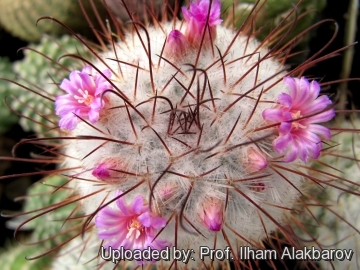 Escobariopsis bombycina (Mammillaria bombycina) Photo by: Prof. Ilham Alakbarov
Escobariopsis bombycina (Mammillaria bombycina) Photo by: Prof. Ilham Alakbarov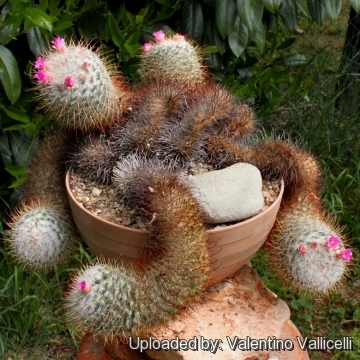 Escobariopsis bombycina (Mammillaria bombycina) Photo by: Valentino Vallicelli
Escobariopsis bombycina (Mammillaria bombycina) Photo by: Valentino Vallicelli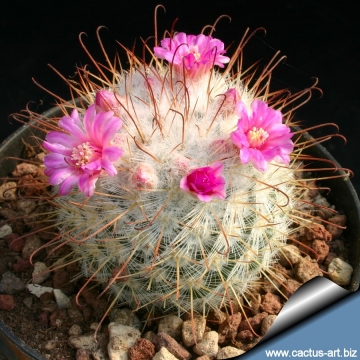 Escobariopsis bombycina (Mammillaria bombycina) Photo by: Cactus Art
Escobariopsis bombycina (Mammillaria bombycina) Photo by: Cactus Art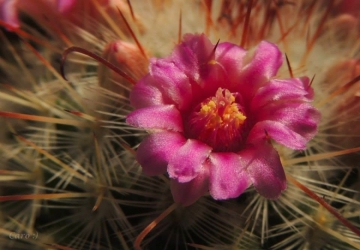 Escobariopsis bombycina (Mammillaria bombycina) Photo by: Carolina González
Escobariopsis bombycina (Mammillaria bombycina) Photo by: Carolina González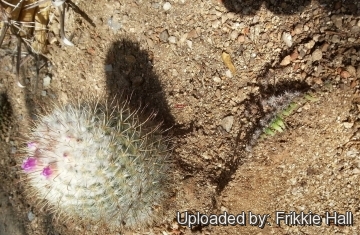 - I was “spring cleaning” my cactus rockery today. I lifted a rock that was close to this Mammillaria bombycina, and was surprised to find this cluster of seedlings hidden under the edge of the rock. Most probably seeds carried in there by ants. Needless to say, these had no water for more than four months and some days the night temperatures as low as -5C.....why do the “baggie method”, just let nature be nature!! I have place the rock back in position, let’s wait a year and see what happened (Mammillaria bombycina) Photo by: Frikkie Hall
- I was “spring cleaning” my cactus rockery today. I lifted a rock that was close to this Mammillaria bombycina, and was surprised to find this cluster of seedlings hidden under the edge of the rock. Most probably seeds carried in there by ants. Needless to say, these had no water for more than four months and some days the night temperatures as low as -5C.....why do the “baggie method”, just let nature be nature!! I have place the rock back in position, let’s wait a year and see what happened (Mammillaria bombycina) Photo by: Frikkie Hall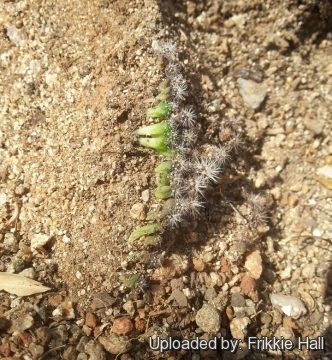 Escobariopsis bombycina (Mammillaria bombycina) Photo by: Frikkie Hall
Escobariopsis bombycina (Mammillaria bombycina) Photo by: Frikkie Hall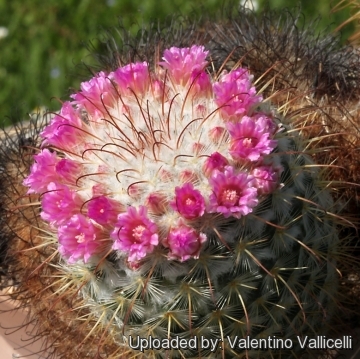 Escobariopsis bombycina (Mammillaria bombycina) Photo by: Valentino Vallicelli
Escobariopsis bombycina (Mammillaria bombycina) Photo by: Valentino Vallicelli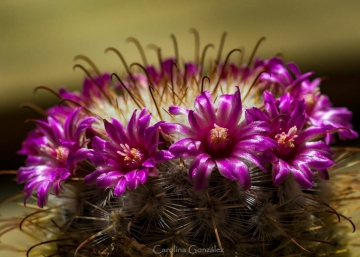 Escobariopsis bombycina (Mammillaria bombycina) Photo by: Carolina González
Escobariopsis bombycina (Mammillaria bombycina) Photo by: Carolina GonzálezCultivation and Propagation: This is one of the easier species to grow, it is an easy bloomer and don't requires any special treatment, it have consistently clean spination whether grown indoors or out but the plants are the most beautiful when cultivated in the full sun that encourage the heaviest spine formation. Regular water in summer. Keep dry in winter. Frost tolerance: 4° C.
Propagation: Seeds or offsets.
Your Photos
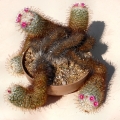
by Valentino Vallicelli

by Cactus Art
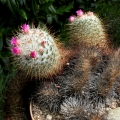
by Valentino Vallicelli





















